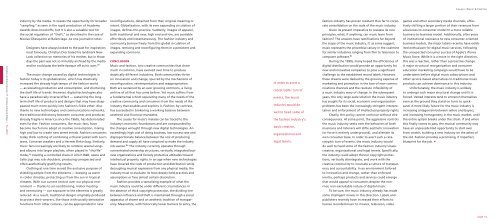Testimony of David Wolfe, Creative Director The ... - Public Knowledge
Testimony of David Wolfe, Creative Director The ... - Public Knowledge
Testimony of David Wolfe, Creative Director The ... - Public Knowledge
You also want an ePaper? Increase the reach of your titles
YUMPU automatically turns print PDFs into web optimized ePapers that Google loves.
E s s a y s : M u s i c & F a s h i o n<br />
industry by the media. It creates the opportunity for broader<br />
reconfigurations, detached from their original meaning or<br />
fashion industry has proven resistant thus far to corpo-<br />
games and other secondary media channels, effec-<br />
“sampling,” as seen in the rapid production <strong>of</strong> Academy<br />
intent. Globalization, with its ever expanding circulation <strong>of</strong><br />
rate consolidation on the scale <strong>of</strong> the music industry.<br />
tively shifting a larger portion <strong>of</strong> their revenues from<br />
Awards dress knock<strong>of</strong>fs, but it is also a valuable tool for<br />
images, defines this practice. Suddenly, images <strong>of</strong> apparel,<br />
Given its present imperative to reassess its core<br />
a business-to-consumer model to a more reliable<br />
the social regulation <strong>of</strong> “theft,” as described in the case <strong>of</strong><br />
both traditional and new, high end and low, are available<br />
principles, what, if anything, can music learn from<br />
business-to-business model. Additionally, after years<br />
Nicolas Ghesquière at Balenciaga. As one journalist notes:<br />
effortlessly and instantaneously. <strong>The</strong> fashion industry and<br />
fashion? <strong>The</strong> answers have ramifications far beyond<br />
<strong>of</strong> institutional resistance to new consumer-oriented<br />
community borrow freely from this global circulation <strong>of</strong><br />
the scope <strong>of</strong> the music industry, if, as some suggest,<br />
business models, the major labels recently have exhib-<br />
Designers have always looked to the past for inspiration;<br />
images, remixing and reconfiguring them in a persistent and<br />
music represents the proverbial canary in the coalmine<br />
ited enthusiasm for digital music services, following<br />
page 64 | Ready to Share: Fashion & the Ownership <strong>of</strong> Creativity<br />
most famously, Christian Dior based his landmark New<br />
Look collection on memories <strong>of</strong> his mother, but in those<br />
days the past was not so minutely archived by the media<br />
and he could pass the belle époque <strong>of</strong>f as his own. 78<br />
<strong>The</strong> major change caused by digital technologies in<br />
fashion today is its globalization, which has drastically<br />
increased the already high tempo <strong>of</strong> the fashion world<br />
— accelerating production and consumption, and shortening<br />
the shelf life <strong>of</strong> trends. However, digital technologies also<br />
have a paradoxically inverse effect — sustaining the longterm<br />
shelf life <strong>of</strong> products and designs that may have disappeared<br />
much more quickly into fashion’s fickle ether. Also<br />
thanks to new technologies and communications networks,<br />
the traditional dichotomy between consumer and producer,<br />
already fragile in America since the 1960s, has deteriorated<br />
even further. Fashion consumers, like music fans, have<br />
become much more adept at creative consumption, mixing<br />
high and low to create new street trends. Fashion consumers<br />
today think nothing <strong>of</strong> combining a Chanel jacket with Levi’s<br />
jeans, Converse sneakers and a Hermès Birkin bag. Similarly,<br />
expanding commons.<br />
conclusion<br />
Music and fashion, two creative communities that share<br />
much in common, have evolved over time to produce<br />
drastically different industries. Both communities thrive<br />
on innovation and change, spurred by the mechanisms <strong>of</strong><br />
reconfiguration, reinterpretation and reappropriation.<br />
Both are sustained by an ever growing commons, a living<br />
archive <strong>of</strong> all that has come before. Yet music suffers from<br />
a fundamental schism separating many <strong>of</strong> the needs <strong>of</strong> the<br />
creative community and consumers from the needs <strong>of</strong> the<br />
industry that enables and exploits it. Fashion, by contrast,<br />
has succeeded in brokering a working balance between<br />
aesthetic and financial mandates.<br />
<strong>The</strong> causes for music’s malaise can be traced to the<br />
industry’s economic foundations and are compounded by<br />
the changes wrought through new digital technologies. An<br />
exceedingly high cost <strong>of</strong> doing business, low success rate and<br />
disproportionate balance between the cost <strong>of</strong> producing<br />
demand and supply all have conspired to make the industry<br />
In order to avert a<br />
catastrophic turn <strong>of</strong><br />
events, the music<br />
industry would do<br />
well to heed some <strong>of</strong><br />
the fashion industry’s<br />
basic creative,<br />
organizational and<br />
legal tenets.<br />
for similar industries ranging from film to television to<br />
computer s<strong>of</strong>tware. 81<br />
During the 1990s, many hoped the efficiencies <strong>of</strong><br />
digital distribution would provide an opportunity for<br />
new and innovative companies to pose a significant<br />
challenge to the established record labels. However,<br />
these dreams were dashed by the growing expense <strong>of</strong><br />
marketing and promotion in the face <strong>of</strong> new communications<br />
channels and the resolute inflexibility <strong>of</strong><br />
a music industry wary <strong>of</strong> change. In the subsequent<br />
years, the only large-scale solution the music industry<br />
has sought for its social, economic and organization<br />
problems has been the increasingly stringent interpretation<br />
and enforcement <strong>of</strong> intellectual property rights.<br />
Clearly, this policy cannot continue without dire<br />
consequences. At some point, the aggressive controls<br />
the music industry seeks over the behaviors <strong>of</strong> both<br />
musicians and listeners will stifle aesthetic innovation<br />
(or force it entirely underground), and alienate its<br />
own consumer base. In order to avert such a catastrophic<br />
turn <strong>of</strong> events, the music industry would<br />
the unexpected consumer success <strong>of</strong> Apple’s iTunes<br />
Music Store. While it is a move in the right direction,<br />
this was a reactive, rather than a proactive change.<br />
A major structural reorganization and consumer<br />
education marketing campaign would have to be<br />
undertaken before digital music subscriptions and<br />
other service-based alternatives to traditional music<br />
products can achieve dominance in this industry.<br />
Unfortunately, the music industry is unlikely<br />
to undergo such major structural change until it is<br />
forced. Vested interests tend to entrench themselves<br />
even as the ground they stand on turns to quicksand.<br />
A more likely future for the music industry is<br />
increasing antagonism between sellers and buyers,<br />
and increasing homogeneity in the music market, until<br />
the entire system breaks under the strain. If and when<br />
this finally comes to pass, the musical community may<br />
have an unprecedented opportunity to start over<br />
from scratch, building a new industry on the ashes <strong>of</strong><br />
the old. Fashion provides a promising, if imperfect,<br />
blueprint for the job. •<br />
music fans increasingly are likely to combine several songs<br />
risk-averse. 80 <strong>The</strong> industry currently operates through<br />
do well to heed some <strong>of</strong> the fashion industry’s basic<br />
and albums into larger playlists, <strong>of</strong>ten played in “shuffle”<br />
concentrated ownership structures, vertically integrated busi-<br />
creative, organizational and legal tenets. Specifically,<br />
mode, 79 creating a controlled chaos in which R&B, opera and<br />
ness organizations and fiercely protective attitudes toward<br />
the industry could adopt thinner copyright protec-<br />
Celtic jigs may rub shoulders, producing unexpected and<br />
intellectual property rights. In an age when new technologies<br />
tions, vertically disintegrate, and work with the<br />
<strong>of</strong>ten aesthetically gratifying results.<br />
have lowered the costs <strong>of</strong> production and distribution while<br />
creative community to inculcate a culture <strong>of</strong> transpar-<br />
Clothing at one time served the exclusive purpose <strong>of</strong><br />
decoupling musical expression from any physical media, the<br />
ency and accountability. In an environment tailored<br />
shielding people from the elements — keeping us warm<br />
industry must re-evaluate its most deeply held practices and<br />
to innovation and change, rather than enforced<br />
in colder climates, protecting us from the sun in tropical<br />
assumptions or face almost certain dissolution.<br />
inertia, perhaps products and services could emerge<br />
climates. With our current control over our physical envi-<br />
Fashion provides a tantalizing example <strong>of</strong> what the<br />
that would appeal to consumers despite the non-<br />
ronment — thanks to air-conditioning, indoor heating<br />
music industry could be under different circumstances. In<br />
rival, non-excludable nature <strong>of</strong> digital music.<br />
and commuting — our exposure to the elements is greatly<br />
the absence <strong>of</strong> thick copyright protection, the dividing line<br />
To be sure, the music industry already has made<br />
reduced. As a result, traditional designs originally produced<br />
between influence and theft is maintained through a social<br />
some intelligent moves in this direction. Labels and<br />
to protect their wearers, like those with socially denotative<br />
apparatus <strong>of</strong> shame and an aesthetic tradition <strong>of</strong> transpar-<br />
publishers recently have increased their efforts to<br />
functions from other cultures, can be appropriated in new<br />
ency. Meanwhile, with historically lower barriers to entry, the<br />
license recorded music to movies, television, video<br />
page 65





